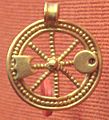Celtic mythology facts for kids
Celtic Mythology refers to the religion and beliefs held by the Celts, an ancient group of people who lived across Europe. Their stories are full of brave heroes, powerful gods, and magical creatures. These myths help us understand how the Celts saw the world and what was important to them.
Contents
Who Were the Celts?
The Celts were a group of people who lived in Europe during the Iron Age, from about 1200 BCE to 400 CE. They spoke Celtic languages and shared similar cultures. Their lands stretched from Ireland and Britain to France (ancient Gaul), Spain, and even parts of Eastern Europe. They were known for their skilled metalwork, unique art, and fierce warriors.
Celtic Culture and Beliefs
The Celts were not a single empire like the Romans. Instead, they were many different tribes who shared a common heritage. Their beliefs were deeply connected to nature, the changing seasons, and the cycles of life and death. They often worshipped gods and goddesses associated with natural elements like rivers, trees, and the sun.
What is Celtic Mythology?
Celtic mythology is the collection of myths and legends from the ancient Celtic people. These stories were usually passed down by word of mouth, from one generation to the next. Later, some of them were written down, especially in Ireland and Wales.
Key Themes in Celtic Myths
Celtic myths often explore themes like:
- Heroic Deeds: Stories of brave warriors performing amazing feats.
- Magic and the Otherworld: Tales involving powerful spells, enchanted objects, and a mystical realm beyond our own.
- Nature's Power: The importance of forests, rivers, and animals.
- Cycles of Life: Birth, death, and rebirth are common ideas.
Important Celtic Gods and Goddesses
The Celts worshipped many different gods and goddesses. Their names and roles could change from one region to another. Here are a few well-known examples:
The Tuatha Dé Danann
In Irish mythology, a group of divine beings called the Tuatha Dé Danann are very important. They are often seen as gods, goddesses, or powerful magical people.
- Lugh: A skilled warrior, craftsman, and sun god. He is known for his many talents and his magic spear.
- The Dagda: A powerful father figure, often called the "Good God." He controls the weather and has a magical club and a cauldron that never empties.
- Brigid: A goddess of poetry, healing, smithcraft, and fire. She is very popular and represents creativity and protection.
Other Celtic Deities
- Taranis: A Gaulish god of thunder, often shown with a wheel and a lightning bolt. He was worshipped in parts of France and Britain.
- Sucellus: A Gaulish god of agriculture, forests, and alcoholic drinks. He is often depicted with a hammer and a pot.
- Cernunnos: A horned god of nature, animals, and fertility. He is often shown sitting cross-legged with animals around him.
Famous Celtic Legends and Heroes
Celtic mythology is rich with exciting stories and legendary figures.
The Ulster Cycle
This is a famous collection of Irish myths, mostly about the heroes of Ulster.
- Cú Chulainn: The most famous hero of the Ulster Cycle. He was a mighty warrior with superhuman strength. His stories tell of his incredible battles and his loyalty.
- The Táin Bó Cúailnge: Also known as "The Cattle Raid of Cooley," this is the central epic of the Ulster Cycle. It tells of a war over a magical bull and Cú Chulainn's heroic defense of Ulster.
The Fenian Cycle
Another important group of Irish myths, focusing on the warrior Fionn mac Cumhaill and his band of warriors, the Fianna.
- Fionn mac Cumhaill: A wise and brave leader of the Fianna. He gained great knowledge by tasting the Salmon of Knowledge.
Welsh Mythology and Arthurian Legends
Welsh mythology is found in texts like the Mabinogion. These stories often feature heroes, magic, and connections to the natural world.
- King Arthur: While often seen as a British legend, the stories of King Arthur and his knights have strong roots in Celtic traditions, especially in Wales. Tales of Arthur, Merlin, and the Knights of the Round Table often include elements of Celtic magic and folklore.
Sources of Celtic Mythology
Most of what we know about Celtic mythology comes from a few key sources:
- Irish Manuscripts: Texts like the Book of Leinster and the Yellow Book of Lecan contain many of the Irish myths.
- Welsh Manuscripts: The Mabinogion, found in books like the Red Book of Hergest, preserves Welsh legends.
- Archaeological Finds: Statues, carvings, and other artifacts found by archaeologists give us clues about Celtic gods and rituals.
- Roman Accounts: Roman writers sometimes wrote about the Celts they encountered, though these accounts can be biased.
Legacy of Celtic Mythology
Even today, Celtic mythology continues to influence our world.
- Literature and Art: Many modern books, movies, and artworks draw inspiration from Celtic myths.
- Place Names: Many places in Ireland, Britain, and France have names that come from Celtic words or legends.
- Modern Paganism: Some modern spiritual practices are inspired by ancient Celtic beliefs.
- Cultural Identity: For many people in Celtic regions, these myths are an important part of their heritage and identity.
Celtic mythology offers a fascinating glimpse into the minds of an ancient people. Their stories of gods, heroes, and magic continue to entertain and inspire us.
Images for kids
-
Votive Celtic wheels thought to correspond to the cult of Taranis. Thousands of such wheels have been found in sanctuaries in Gallia Belgica, dating from 50 BCE to 50 CE. National Archaeological Museum, France
-
Taranis (with Celtic wheel and thunderbolt), Le Chatelet, Gourzon, Haute-Marne, France
-
Golden Celtic wheel with symbols, Balesme, Haute-Marne. National Archaeological Museum
See also
 In Spanish: Mitología celta para niños
In Spanish: Mitología celta para niños









